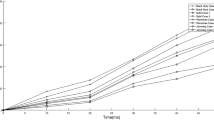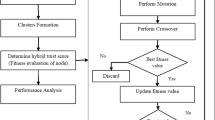Abstract
Wireless sensor network (WSN) becomes a hot research topic owing to its application in different fields. Minimizing the energy dissipation, maximizing the network lifetime, and security are considered as the major quality of service (QoS) factors in the design of WSN. Clustering is a commonly employed energy-efficient technique; however, it results in a hot spot issue. This paper develops a novel secure unequal clustering protocol with intrusion detection technique to achieve QoS parameters like energy, lifetime, and security. Initially, the proposed model uses adaptive neuro fuzzy based clustering technique to select the tentative cluster heads (TCHs) using three input parameters such as residual energy, distance to base station (BS), and distance to neighbors. Then, the TCHs compete for final CHs and the optimal CHs are selected using the deer hunting optimization (DHO) algorithm. The DHO based clustering technique derives a fitness function using residual energy, distance to BS, node degree, node centrality, and link quality. To further improve the performance of the proposed method, the cluster maintenance phase is utilized for load balancing. Finally, to achieve security in cluster based WSN, an effective intrusion detection system using a deep belief network is executed on the CHs to identify the presence of intruders in the network. An extensive set of experiments were performed to ensure the superior performance of the proposed method interms of energy efficiency, network lifetime, packet delivery ratio, average delay, and intrusion detection rate.













Similar content being viewed by others
References
Akyildiz, I. F., Su, W., Sankarasubramaniam, Y., & Cayirci, E. (2002). Wireless sensor networks: A survey. Computer Networks, 38, 393–422.
Raghavendra, C. S., Sivalingam, K. M., & Znati, T. (2004). Wireless sensor networks. USA: Springer.
Soro, S., & Heinzelman, W. B. (2005). Prolonging the lifetime of wireless sensor networks via prolonging the lifetime of wireless sensor networks via. In 19th IEEE international parallel distributed processing symposium.
Kaur, G., & Varsha, . (2016). Review on hierarchical unequal clustering based protocols in wireless sensor network. The International Journal on Recent and Innovation Trends in Computing and Communication, 4, 96–99.
Vennira Selvi, G., & Manoharan, R. (2013). A survey of energy efficient unequal clustering algorithms for wireless sensor networks. International Journal of Computers and Applications, 79, 0975–8887.
Zadeh, L. A. (1965). Fuzzy sets. Information Control, 8, 338–353.
Zadeh, L. A. (1973). Outline of a new approach to the analysis of complex systems and decision processes. IEEE Transactions on Systems, Man, and Cybernetics Part C: Applications and Reviews, 3, 28–44.
Molay, Z., Akbari, R., Shokouhifar, M., & Safaei, F. (2016). Swarm intelligence based fuzzy routing protocol for clustered wireless sensor networks. Expert Systems with Applications, 55, 313–328. https://doi.org/10.1016/jeswa201602016.
Ran, G., et al. (2010). Improving on LEACH protocol of wireless sensor networks using fuzzy logic. Journal of Information and Computing Science, 7, 767–775.
Singh, M., Gaurav Kumar, V., & Soni, S. (2016). Clustering using fuzzy logic in wireless sensor network. In The 3rd international conference on computing for sustainable global development (INDIACom) 2016, New Delhi.
Bagci, H., & Yazici, A. (2010). An energy aware fuzzy unequal clustering algorithm for wireless sensor networks. In 2010 IEEE international conference on fuzzy system (FUZZ), 18–23 July 2010 (pp. 1–8).
Mao, S., Zhao, C., Zhou, Z., & Ye, Y. (2012). An improved fuzzy unequal clustering algorithm for wireless sensor Network. Mobile Networks Applications, 4, 206–214. https://doi.org/10.1007/s11036-012-0356-4.
Logambigai, R., & Kannan, A. (2016). Fuzzy logic based unequal clustering for wireless sensor networks. Wireless Networks, 22, 945–957. https://doi.org/10.1007/s11276-015-1013-1.
Baranidharan, B., & Santhi, B. (2016). DUCF: Distributed load balancing Unequal Clustering in wireless sensor networks using Fuzzy approach. Applied Soft Computing Journal, 40, 495–506. https://doi.org/10.1016/jasoc201511044.
Gajjar, S., Sarkar, M., & Dasgupta, K. (2014). FAMACRO: Fuzzy and ant colony optimization based MAC/routing cross-layer protocol for wireless sensor networks. Applied Soft Computing, 6, 235–247.
Kumar Kashyap, P., Kumar, S., Dohare, U., Kumar, V., & Kharel, R. (2019). Green computing in sensors-enabled internet of things: neuro fuzzy logic-based load balancing. Electronics, 8(4), 384.
Balakrishnan, N., Rajendran, A., Pelusi, D., & Ponnusamy, V. (2019). Deep belief network enhanced intrusion detection system to prevent security breach in the internet of things. In Internet of things (p.100112).
Salehian, S., & Subraminiam, S. K. (2015). Unequal clustering by improved particle swarm optimization in wireless sensor network. Procedia Computer Science, 62, 403–409.
Karthick, P. T., & Palanisamy, C. (2019). Optimized cluster head selection using krill herd algorithm for wireless sensor network. Automatika, 60(3), 340–348.
Arjunan, S., Pothula, S., & Ponnurangam, D. (2018). F5N-based unequal clustering protocol (F5NUCP) for wireless sensor networks. International Journal of Communication Systems, 31(17), e3811.
Arjunan, S., & Sujatha, P. (2018). Lifetime maximization of wireless sensor network using fuzzy based unequal clustering and ACO based routing hybrid protocol. Applied Intelligence, 48(8), 2229–2246.
Zhang, W., Han, D., Li, K. C., & Massetto, F. I. (2020). Wireless sensor network intrusion detection system based on MK-ELM. Soft Computing, 76, 1–14.
Brammya, G., Praveena, S., Ninu Preetha, N. S., Ramya, R., Rajakumar, B. R., & Binu, D. (2019). Deer hunting optimization algorithm: A new nature-inspired meta-heuristic paradigm. The Computer Journal. https://doi.org/10.1093/comjnl/bxy133.
Funding
Not applicable.
Author information
Authors and Affiliations
Corresponding author
Ethics declarations
Conflict of interest
The authors declare that they have no conflict of interest.
Additional information
Publisher's Note
Springer Nature remains neutral with regard to jurisdictional claims in published maps and institutional affiliations.
Rights and permissions
About this article
Cite this article
Maheswari, M., Karthika, R.A. A Novel QoS Based Secure Unequal Clustering Protocol with Intrusion Detection System in Wireless Sensor Networks. Wireless Pers Commun 118, 1535–1557 (2021). https://doi.org/10.1007/s11277-021-08101-2
Accepted:
Published:
Issue Date:
DOI: https://doi.org/10.1007/s11277-021-08101-2




